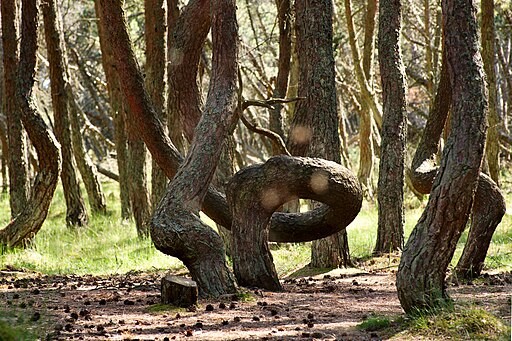A forest in Russia has been shrouded in mystery and intrigue as the trees seem to move and dance in a way that defies scientific explanation.

Mysterious Dancing Forest
On the Curonian Spit in Kaliningrad, Russia lies a small patch of pine forest that measures only 800 square meters (8,611 square feet) wide. This national park, recognized as a UNESCO World Heritage site, lies between the Baltic Sea and the Curonian Lagoon.
One of the most remarkable features of this forest is its strange geological makeup. The Curonian Spit is a narrow strip of land formed by the movement of sand dunes and glacial deposits. The soil in this region is also very porous and contains a high concentration of sand and clay. This unusual feature has led to developing a unique ecosystem with various plants and animals.
The trees in this forest were planted in the 1960s to stabilize the dune sands in the area. Before World War II, the site accommodated a Nazi German gliding school. Because of the strange appearance of the trees, this site has gained its title as the Dancing Forest.
Unlike drunken trees, the trees in this Dancing Forest are twisted into different patterns. Some trees form knots, loops, hearts, and even convoluted spirals that bend to the ground. In other trees, the trunks are curved and bent, and some are even twisted or curled into a ring, stretching upward to find their way to the sky. These patterns give the impression that the trees are dancing.
READ ALSO: Ecologists Find That Sierra Nevada Forest Has Higher Tree Density Than Previously Studied
Theories Behind the Unusual Tree Formations
Over the years, the Dancing Forest has been the subject of scientific studies and speculations. Many scientific studies have been done to unveil the cause of tree morphing, but the findings have always been inconclusive. Some experts conclude that the strange tree shapes result from several combined factors. Nonetheless, the exact cause of the distortion of the trees remains unknown.
One theory suggests that pine shoot moth caterpillars damage the trees at an early age, causing them to start growing with unusual shapes with odd angles. Experts believe that the caterpillars of the butterfly Rhyacionia buoliana eat the developing apical and lateral buds of the pine trees. Once the apical bud of the tree is destroyed, growth only occurs with its less damaged lateral buds. Since these plants need sunlight, they correct themselves as they grow taller, but their strange shapes remain their characteristic feature.
Some people believe the trees in this forest are trained to grow that way. Humans have learned to manipulate trees for commercial or aesthetic purposes. A young tree can be trained to grow in unconventional ways by laying a heavy object on its trunk for an extended period. Just like any other plant, these trees will grow toward the sun in a process called phototropism. Whether these plants are made to bend intentionally or not, the effects of phototropism can change the characteristics of their tissues.
According to a folk version, the mystery of the Dancing Forest likely has a geological cause. The trees seem to follow the sands' movement, making the soil unstable. A widely accepted view suggests that the growing trees in this forest are manipulated by strong winds that regularly blow in the area. Another hypothesis is that the morphing of trees is the result of seismic activity or the presence of underground water sources. For others, it could be due to nuclear radiation or geomagnetic solid fields.
RELATED ARTICLE: Underwater Ancient Forest Uncovered After The Storm Hit Wales
Check out more news and information on Forest in Science Times.




![Earth's Quasi-Moon Kamo‘oalewa Could Originate From Lunar Surface Not Asteroid Belt [Study]](https://1721181113.rsc.cdn77.org/data/thumbs/full/53275/89/56/50/40/earths-quasi-moon-kamo-oalewa-could-originate-from-lunar-surface-not-asteroid-belt-study.png)









